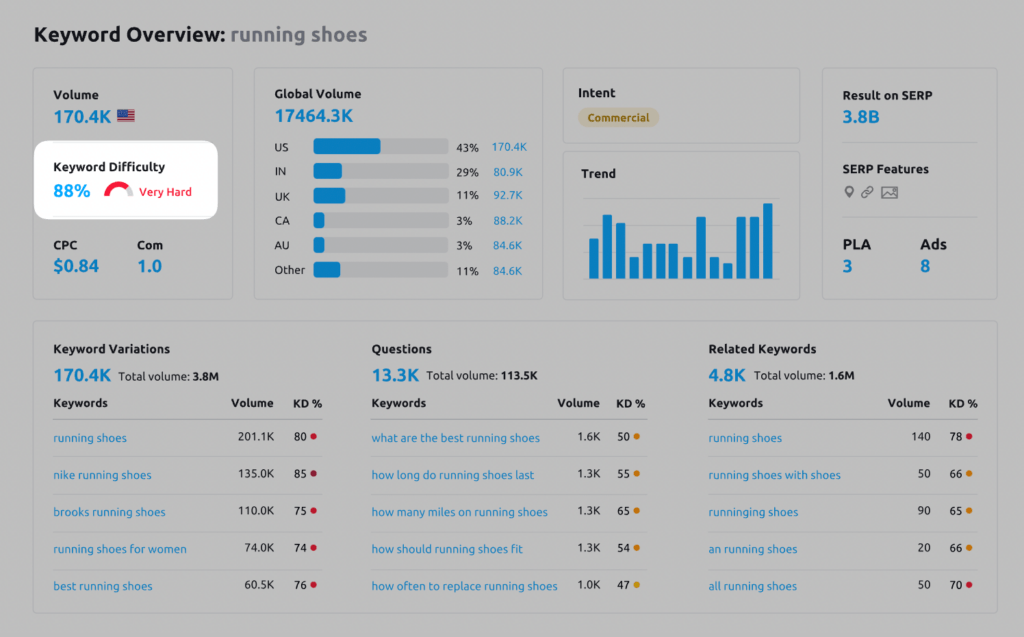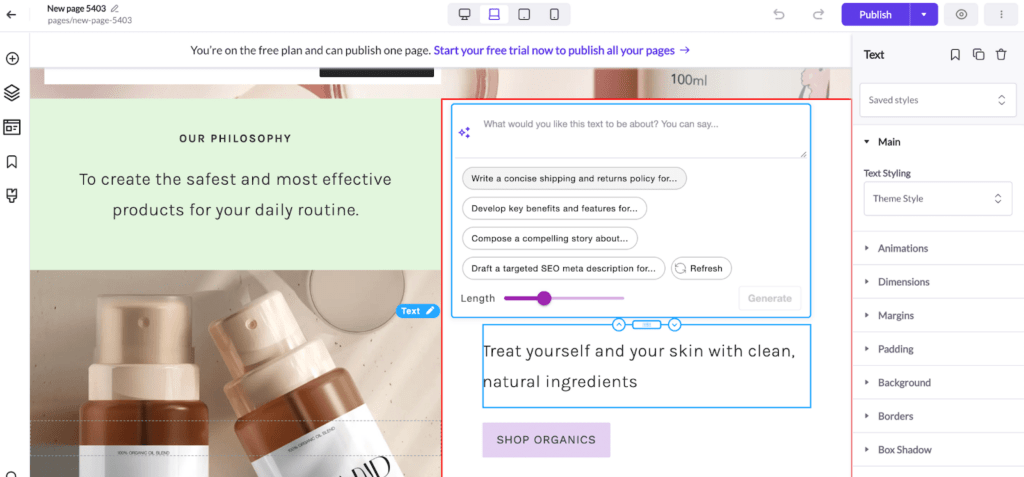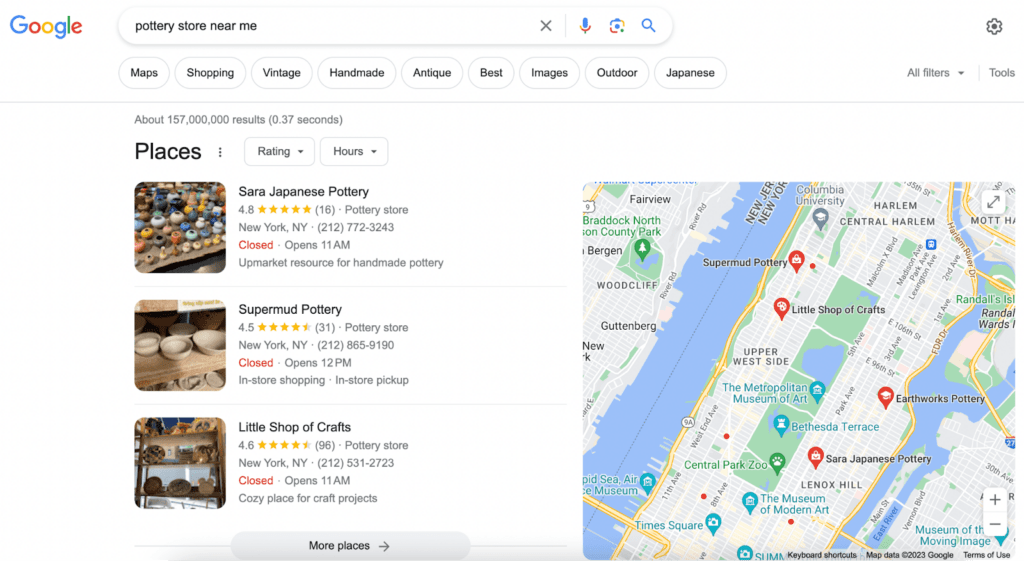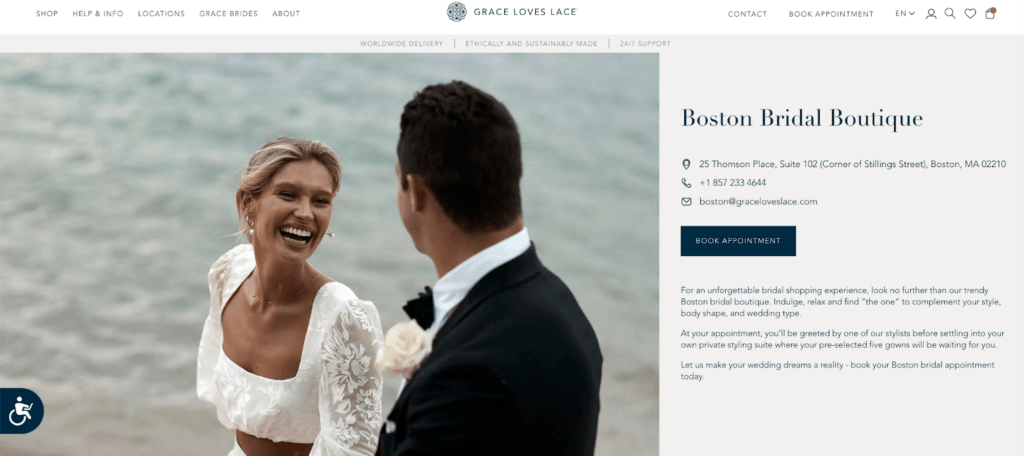Shopify SEO Checklist: 22 Boxes to Check Off To Increase Organic Traffic

Optimizing your Shopify store is a mammoth task.
From optimizing images to ensuring the technical side of your website is formatted correctly, things can often fall through the cracks and tank your store’s organic performance.
This guide exists to solve that problem.
In this article, we’ll give you a comprehensive search engine optimization (SEO) checklist specifically designed for Shopify store owners—so you can optimize your entire store and drive qualified traffic from search engines.
We’ll cover:
#cta-visual-pb#<cta-title>SEO tools included as standard<cta-title>Create incredible shopping experiences that are optimized for search and performance with Shogun Page Builder.Get started for free
Shopify SEO prep: What to do before you get started
Before diving into the checklist, let’s cover the foundations that any solid SEO strategy needs.
Define your target audience
Much like any other marketing strategy, your Shopify SEO checklist should start with a strong understanding of your target audience.
A thorough understanding of your target audience ensures you’re driving high-quality traffic to your Shopify site (as opposed to lots of traffic that doesn’t convert.)
It also helps you understand the search behavior of your potential customers so you can reverse-engineer your website SEO strategy to reach them.
So, before you get started, define your buyer personas. Write down the following traits your ideal customers share:
- Age
- Location
- Interests and hobbies
- Pain points
- Shopping behavior
- Purchase motivation
Keyword research
Keyword research underpins almost every SEO activity you do on your Shopify site.
Why?
Because text is one of the most important things a search engine uses to determine the context of your ecommerce website.
If you can match your website content with the search queries someone would use to find it, you’ll increase the odds of appearing in those search results.
Start by figuring out which terms your target customer is searching for using keyword research tools like Semrush, Ahrefs, or Moz.
Pay attention to these three factors:
- Relevancy. There isn’t much commercial value in targeting “shoes” if you don’t sell them on your Shopify website. Make sure any target keyword is relevant to the products you sell.
- Search volume. This metric shows how many people search for that specific term each month. While keywords with a high search volume can drive thousands of searches to your Shopify store each month, it’s likely much harder to rank for them. Existing websites with tons of authority are probably claiming the top spots.
- Keyword difficulty. This metric tells you how difficult it would be to rank for each keyword. If you’re a new Shopify store or just starting to optimize your website, you’ll see quicker results by prioritizing terms that are still relevant to your store, but with a low keyword difficulty.

Once you’ve shortlisted potential keywords, it’s time to use them.
Categorize all keywords into one of three buckets, depending on the intent of the user searching for them. This informs how you’ll target them on your Shopify site:
- Informational. Informational keywords indicate a searcher is looking to learn something—for example, “benefits of walking”. These make for excellent blog posts where you have the opportunity to educate potential shoppers when they’re most impressionable.
- Commercial. Commercial keywords indicate a searcher is looking to buy something, but isn’t quite ready to convert. An example would be “compare walking pads”. Target these terms on Shopify collection pages which give hesitant shoppers greater choice.
- Transactional. Transactional keywords indicate the searcher wants to buy something, such as “buy walking pad”. Divert these users towards your product pages by including transactional phrases across title tags, product descriptions, and anchor text in internal links.
Assemble your SEO toolkit
Shopify comes with a bunch of built-in SEO features for website owners—including the ability to edit meta titles and descriptions, create a sitemap, and write alt tags for product images. (More on this later.)
But there are some elements of an ecommerce SEO strategy that Shopify isn’t best-equipped to handle. For that reason, the Shopify App Store is home to some of the best SEO tools that integrate directly with your ecommerce platform.
The best SEO toolstack covers all of these bases:
- Keyword tracking using tools like Ahrefs or Semrush
- Image optimization with apps like Tiny:SEO
- Schema markup using tools like Webrex
- SEO analytics platforms like Google Search Console and Google Analytics
- A Shopify landing page builder like Shogun
#cta-visual-pb#<cta-title>Build your store without coding<cta-title>Design the store of your dreams without writing a line of code with Shogun Page Builder, plus get SEO and performance insights directly in the editor.Get started for free
Shopify technical SEO checklist
Technical SEO covers the improvements you make to your site’s code, hierarchy, or structure. Below are the six most important Shopify technical SEO considerations.
Optimize your URL structure
The URL structure plays a significant role in helping search engines understand the content and hierarchy of your Shopify website.
When your URLs reflect the category and product hierarchy, it provides a logical structure that helps search engines determine the relevance of the content to user queries—ultimately affecting how your web pages are ranked in search results.
Backlinko found the sweet spot for page URLs is 66 characters, though shorter URLs outperform longer URLs.
Well-optimized Shopify URLs also use a custom domain, replace spaces with hyphens, and keep numbers to a minimum.
Let’s put that into practice for a Shopify store using the following category and product structure:
- Category: Handmade candles
- ✅ mystore.com/collection/handmade-candles
- ❌ mystore.com/collection/candles_madebyhand
- Product: Soy wax candles
- ✅ mystore.com/products/soy-wax-candle
- ❌ mystore.com/products/soy-candle-8204
Make your store mobile-friendly
Shopify stores need to be mobile-friendly for SEO because 63% of internet users access search engines on their mobile device.
Search engines prioritize user experience, but if your store isn’t mobile-friendly, frustrated users might leave quickly. This high bounce rate tells search engines that your site might not have what people are looking for, which can hurt your search engine rankings.
Techniques to make your Shopify store more mobile-friendly include:
- Using visual hierarchy to prioritize a page’s most valuable content above the fold
- Making buttons large and finger-friendly
- Automatically resizing page content based on the screen it’s loaded on (also known as responsive design)
Create an XML sitemap
An XML sitemap is a virtual roadmap that lists all the important pages of your website in a structured format.
With an in-depth view of your site’s structure and content, it’s easier for search engine crawlers to navigate and index your Shopify pages.
Shopify automatically produces a sitemap.XML file for all merchants. You can find yours by adding “/sitemap.xml” to the end of your store domain.
Copy and paste this URL into Google Search Console.
Optimize ecommerce navigation
Your ecommerce navigation goes a long way in making it easy for online shoppers to find what they’re looking for.
Clear navigation also helps search engine bots crawl and index your pages effectively, enhancing your chances of ranking higher in search results.
Optimize your ecommerce navigation by:
- Using parent and child categories
- Ensuring the navigation bar collapses on mobile
- Displaying breadcrumbs so search visitors can find another relevant product related to the one that appeared in search
Take a look at this example on Nuun’s Shopify store.
Visitors can easily find their way around the ecommerce site. Search engines can also get more context on sports tablets—which is neatly filed beneath the parent category “Hydration tablets”—when deciding where each page should rank in search.

Fix broken links
When a link on your Shopify store leads to a page that doesn’t exist, it’s called a broken link.
Search engines that repeatedly find broken links on your site might assume your content isn’t reliable or valuable. It also worsens the user experience if a searcher has trouble interacting with your site.
As a result, your SEO rankings could take a hit, and your Shopify store might not show up as prominently in search results.
Use SEO tools like Ahrefs or Semrush to identify broken links on your ecommerce store. Then, use a Shopify app like Easy Redirects to send the broken link to the next-most relevant URL via 301 redirect.
For example:
#cta-paragraph-pb#/collections/womens-large-hoodies ➡️ /collections/womens-hoodies
Now with Shogun Insights, you can quickly identify issues like broken links right from the editor, so you can fix it before it publishes.
Improve site speed
Shopify stores that load quickly provide better user experiences, which is something all search engines prioritize in their algorithms.
Slow websites can frustrate users, leading them to hit the back button and choose another site.
This high bounce rate signals to search engines that your site might not be offering what people want, potentially leading to lower SEO rankings.
Aim for a two-second loading speed across your store. Check your current speed using Google PageSpeed Insights and trim waiting times down by:
- Compressing images
- Minifying code
- Limiting pop-ups and plugins
- Enabling browser caching
- Using a Content Delivery Network (CDN)
On-page SEO checklist for Shopify
On-page SEO is the process of optimizing individual pages across your Shopify store. From internal links to content marketing, here are six checkboxes you should tick.
Write meta tags for each page
Meta titles and meta descriptions appear in search engine results and greatly influence your organic click-through rate (CTR). You can edit them by heading to the “Search engine listing” section of your product listing dashboard:

When optimizing your Shopify meta tags, the goal is to prove to search engines that your page is relevant while also enticing searchers to click through.
Rich Hastings, owner of NW Straps, adds:
“Fill out your page title and description using long tail keywords in a way that is easily readable. Just doing this landed us up an average of 50 spots on our search rating, improved our impressions and web traffic by 1,000%.”
#cta-visual-pb#<cta-title>Save time writing meta tags<cta-title>Shogun’s generative AI features can write meta titles and descriptions for you in record time.Start building for free
Add descriptive alt text
Search engines can’t see images in the same way humans can.
By providing descriptive alt text for each image on your Shopify store, you’re giving search engines context to accurately index your images and understand their relevance to your page content.
When writing optimized alt text for images on your Shopify site:
- Aim for accuracy and conciseness
- Use natural language
- Include the page’s keywords but don’t overuse them
These concepts also apply to image file names. Before uploading images to your Shopify store, rename the file from “IMG-395” to something more descriptive (such as “green-stationery-kit”).
Produce unique product descriptions
Shopify product descriptions influence sales by providing potential customers with key information about your products.
From an SEO perspective, they play a significant role in improving your store’s visibility and rankings in search engine results. By strategically incorporating relevant keywords into your product descriptions, you’re telling search engines what your products are about.
Tick this off your Shopify SEO checklist with Shogun AI Text. The generative AI software will write product descriptions for you, based on a single prompt:

“Our most impactful SEO technique was the implementation of long-tail keywords that are closely related to our product selection,” says Wendy Wang, owner of F&J Outdoors. “This has drastically boosted our search rankings, funneling more organic traffic to our website and increasing our visibility for our target audience.
“Since implementing this strategy, we’ve seen an uplift of around 35% in our organic traffic. In addition, we now rank on the first page for more than 25 long-tail keywords related to outdoor furniture covers.”
Create a Shopify blog
A Shopify blog is a powerful tool for not only communicating with potential customers, but also improving your SEO performance.
Blog posts allow you to target specific keywords, answer customer questions, and showcase your expertise with quality content—all of which can improve your website’s authority and search engine visibility.
Zach Dannett, co-founder of Tumble, took this content marketing approach. He started by identifying both primary and secondary keywords—the latter of which included “pet-friendly rug”, “dog-friendly rugs”, and “washable area rugs”.
In a bid to use these secondary keywords more impressively, Zach says:
“We hired professional SEO copywriters to write our blog posts. This made a big difference. We worked with the writers to create a monthly editorial calendar that outlined the content we wanted to produce. The writers then inserted the most effective keywords into the articles.”
“After six months, we reached the top spot for our primary keyword,” Zach says. “Our secondary keywords also ranked well, appearing in the top 8-10 spots on the first page of search engine results pages (SERPs).”

Add Schema markup
Schema markup, also known as structured data, is a code that you can add to your Shopify store’s HTML to provide search engines with additional context about your page content.
Use this Schema Markup Generator to enable rich snippets, which are enhanced search results that provide more information to users directly in the search results page.
For Shopify stores, this might include:
- Product prices—including promotions
- Customer ratings
- Availability
- Fulfillment options (e.g., buy online, pickup in-store)
- Returns policy
Allbirds, for example, uses Schema markup on its Shopify product pages to display a sneaker’s rating, reviews, and price:

Build internal links
Internal links guide shoppers around your website.
They also help search engines navigate your Shopify store and use anchor text—the copy you’re linking over—to get more context on the page you’re linking to.
As part of your Shopify SEO checklist, find internal linking opportunities on your Shopify store. Quick wins include:
- Linking to product pages in the “You may also like” section of existing product pages
- Linking to category pages in your Shopify blog posts
- Linking to your homepage from the About page on your Shopify store
“Gone are the days of just ranking a single page of your website. You need to thoroughly cover the topic that your ecommerce site sells. If you can be the most thorough website on the topic, Google has no choice but to rank you.”
— Christian Sculthorp, founder of Wallpanels
Off-page SEO checklist for Shopify
Off-page SEO refers to the optimizations you do elsewhere. From directory sites to social media, tick these things off your checklist for total store optimization.
Collect customer reviews
Customer reviews supercharge online conversions. They also have the potential to improve your Shopify store’s SEO performance when used correctly.
Reviews add user-generated content to your product pages which can naturally incorporate relevant keywords and phrases that potential customers might search for.
In other words: it’s a way to target secondary keywords on your product pages outside the main description.
Use Shopify apps like Judge.me, Loox, or Yotpo (all of which integrate with Shogun) to configure automated emails that ask new customers to leave a review after their purchase.
That way, you have a constant pipeline of glowing reviews that not only improve your Shopify conversion rate, but improve SEO performance, too.

Build high-quality backlinks
Search engines want to know that the sites they’re directing users to are helpful, trustworthy, and valuable.
Backlinks—external links from another website pointing to your Shopify store—go a long way in building this credibility. Search engines see it as another site vouching for you.
The more vouches you get, the more credible your Shopify store appears.
Link-building techniques to start with include:
- Responding to journalist requests on sites like HARO or Help a B2B Writer
- Sending free samples to bloggers to write a review on their website
- Repairing broken links pointing to your store
- Writing guest posts or sponsored content for publications in your niche
- Creating linkable assets such as how-to guides or quizzes
“When I build backlinks, my sites rank higher. That’s the truth. The easiest way for ecommerce sites to build backlinks is to reach out to vendors, software or anybody that you currently work with and ask for a link. It doesn’t need to be complicated.”
— Christian Sculthorp, founder of Wallpanels
Bear in mind that not any backlink is a good backlink. Affiliating your site with low-quality or spam websites can give Google the same impression of your Shopify store.
Optimize your social media accounts
Social media doesn’t directly correlate with SEO performance, but optimizing your online profiles can inflate other important SEO metrics.
For example:
- Posting on social media builds backlinks to your Shopify store
- Promoting Shopify blog posts can increase the number of people interacting with your store
- Social media profiles can appear in branded search results
Comb through your social media strategy and ensure you’re maximizing the SEO potential you can derive from it.
This means optimizing your bio to include keywords, regularly promoting your blog content, and driving website traffic to your Shopify store.
Local Shopify SEO checklist
If you’re a merchant that operates brick-and-mortar stores alongside your Shopify site, you’ll need this local SEO checklist.
Create a Google My Business listing
If you have a brick-and-mortar store alongside your Shopify ecommerce website, or perhaps serve customers from a physical location (like a warehouse), you’ll need a Google My Business listing.
A Google My Business listing helps you reach the 87% of people who use Google to evaluate local businesses. When people search for businesses in your area, your listing can appear prominently on Google Maps and the local search pack.
The best part? Customers can leave reviews on your Google My Business listing.
Not only will local shoppers be armed with glowing reviews that make visiting your store a no-brainer, but Google can take positive reviews as a signal that your online store is worth promoting.

Join online directories
Online directories exist to help people within a certain location find local businesses.
When your store is listed on reputable directories, it signals to search engines that your Shopify store is legitimate and relevant to local searches.
Many directories also provide backlinks to a merchant’s website, helping you build your backlink profile while attracting local searchers.
Start with global directories like Yelp or Yell. Then, request to join directories in each location your Shopify store operates.
Create local landing pages
Local landing pages are URLs on your Shopify store that provide information to local shoppers. This can include your store’s:
- Opening hours
- Address
- Telephone number
The SEO benefit of local landing pages is that you’ll have unique URLs to target location-specific keywords, such as “shoe store in Tampa” or “pottery studio near Los Angeles”.
Remember: the more often you incorporate keywords into your store’s website copy, the greater chance you have at ranking for related searches.
Take a look at this example on Grace Loves Lace’s Shopify store for inspiration:

Ensure consistency in NAP listings
NAP—which stands for name, address, and phone number—is an important SEO consideration for local businesses optimizing their ecommerce store.
The ultimate goal of any search engine is to provide users with high-quality results.
Businesses with consistent NAP data prove your credibility, helping Google to cement your Shopify store as meeting the criteria for a trustworthy listing.
Work through any existing directory listings and ensure your business’ NAP information is still accurate.
You’d be surprised at how many listings often fall through the cracks when you’re changing business addresses or phone numbers.
Shopify SEO analytics checklist
Tracking your Shopify SEO performance tells you how effective your SEO strategy is.
With so many metrics available inside your Shopify or Google Search Console dashboard, it can be difficult to figure out which KPIs are worth tracking—and which are vanity metrics that give no insight into your SEO performance.
The following metrics will help you analyze success as you work through this Shopify SEO checklist:
- Organic traffic: The total number of people who visit your website after seeing it listed in an organic search result. An increase in organic traffic isn’t only a sign that your search visibility is increasing, but that people who encourage your listing find it relevant enough to click through.
- Keyword rankings: The position of specific keywords in search results. The ideal spot is position one—studies have shown that pages that take the top spot account for 27.6% of all clicks.
- Traffic value: This figure is Ahrefs’ estimate of how much you’d have to spend on paid advertisements to get the same amount of organic traffic. It’s calculated by multiplying the monthly paid traffic of a keyword by the CPC value.
- Organic conversions: Create a segment inside Google Analytics to only display data from people who visit your website through organic search. Look at the conversion rate of this segment to understand the quality of search traffic (though bear in mind that a poorly-optimized page may leak conversions even if traffic is high-quality).
- Assisted organic conversions. Much like shoppers from other marketing channels, not all search visitors will convert into paying customers during their first visit. Google Analytics’ assisted conversions report shows how organic factors into the typical customer journey.
Wendy Wang, owner of F&J Outdoors, says: “We use Google Analytics to monitor our organic traffic alongside Shopify’s built-in analytics to keep an eye on customer behavior and conversion rates.”
“Our top priorities are site visits, dwell time, and the bounce rate,” Wendy adds. “We find these metrics particularly valuable as they not only indicate our website’s engagement but also the user-experience.”
#cta-mini-pb#Ready to start designing better Shopify store pages? Get started for free
Shopify SEO checklist FAQs
How important is SEO for my Shopify store?
SEO is an incredibly effective way to drive qualified traffic to your Shopify store. It gives you the chance to appear in the search results of potential shoppers who are actively looking for the products you sell through your online store.
What are the most common Shopify SEO mistakes?
Duplicate content, no internal links, and slow site speed are among the biggest Shopify SEO issues. This checklist exists to make sure you don’t miss any easy opportunities to grow your search traffic.
How long does it take to see results from SEO on Shopify?
SEO is a long-term strategy. It can take up to a year for Google to index your website, gather search traffic data, and begin to display your Shopify store on the first page of its search results.
Can I do SEO for my Shopify store myself, or should I hire a professional?
It is possible to do your own optimization using this Shopify SEO checklist. However, if you’re short on time or want to outsource SEO, you can do so using one of Shopify’s partner agencies or SEO apps.
Optimize your store with this Shopify SEO checklist
Optimizing a Shopify store is no small feat—but it’s a job made easier with this comprehensive Shopify SEO checklist.
Work through the checklist to start improving your store’s search visibility.
From optimizing meta tags with AI SEO and identifying technical issues with Shogun Insights to using Shogun AI Text to write impressive product descriptions, you can do it all with Shogun Page Builder.
#cta-visual-pb#<cta-title>Tick off your Shopify SEO checklist with Shogun<cta-title>Shogun Insights will audit the page you are working on and give scores and suggestions for things to improve, like SEO, performance, and accessibility.Start building for free

Elise Dopson
Elise Dopson is a freelance writer for B2B commerce and martech companies. When she's not writing, you'll find her in the Peak Freelance community or on Twitter.



